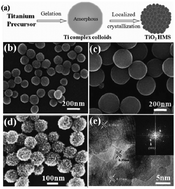Hierarchical TiO2 microspheres: synthesis, structural control and their applications in dye-sensitized solar cells
Abstract

- This article is part of the themed collection: Recent Advances in Solar Energy Conversion and Utilization
* Corresponding authors
a
Beijing National Laboratory for Molecular Sciences, State Key Laboratory for Structural Chemistry of Unstable and Stable Species, College of Chemistry and Molecular Engineering, Peking University, Beijing 100871, P. R. China
E-mail:
dsxu@pku.edu.cn
Fax: 86-10-62760360
Tel: 86-10-62760360
b College of Chemistry and Environmental Science, Henan Normal University, Henan Xinxiang 453007, P. R. China

 Please wait while we load your content...
Something went wrong. Try again?
Please wait while we load your content...
Something went wrong. Try again?
F. Zhu, D. Wu, Q. Li, H. Dong, J. Li, K. Jiang and D. Xu, RSC Adv., 2012, 2, 11629 DOI: 10.1039/C2RA22043A
To request permission to reproduce material from this article, please go to the Copyright Clearance Center request page.
If you are an author contributing to an RSC publication, you do not need to request permission provided correct acknowledgement is given.
If you are the author of this article, you do not need to request permission to reproduce figures and diagrams provided correct acknowledgement is given. If you want to reproduce the whole article in a third-party publication (excluding your thesis/dissertation for which permission is not required) please go to the Copyright Clearance Center request page.
Read more about how to correctly acknowledge RSC content.
 Fetching data from CrossRef.
Fetching data from CrossRef.
This may take some time to load.
Loading related content
